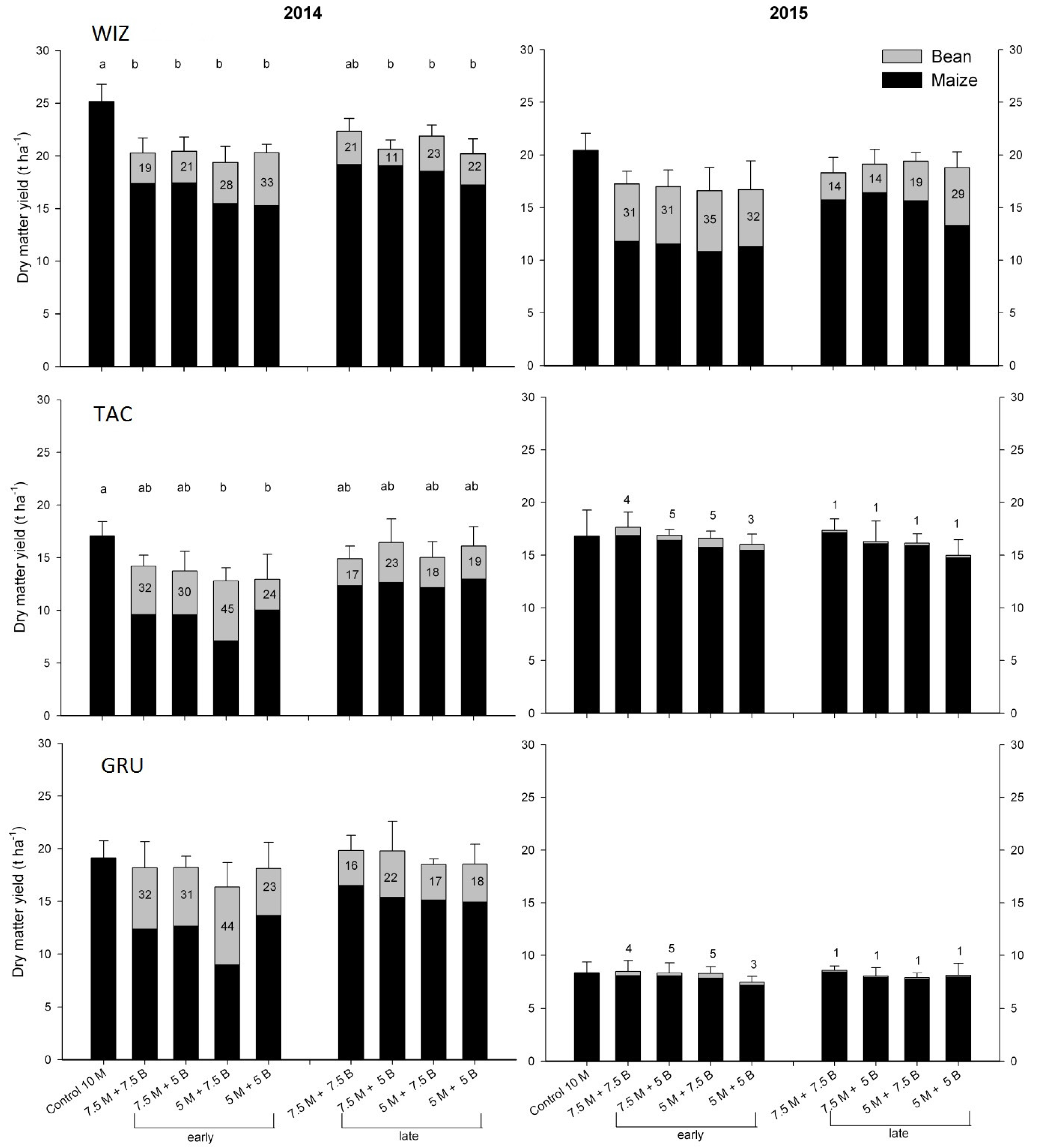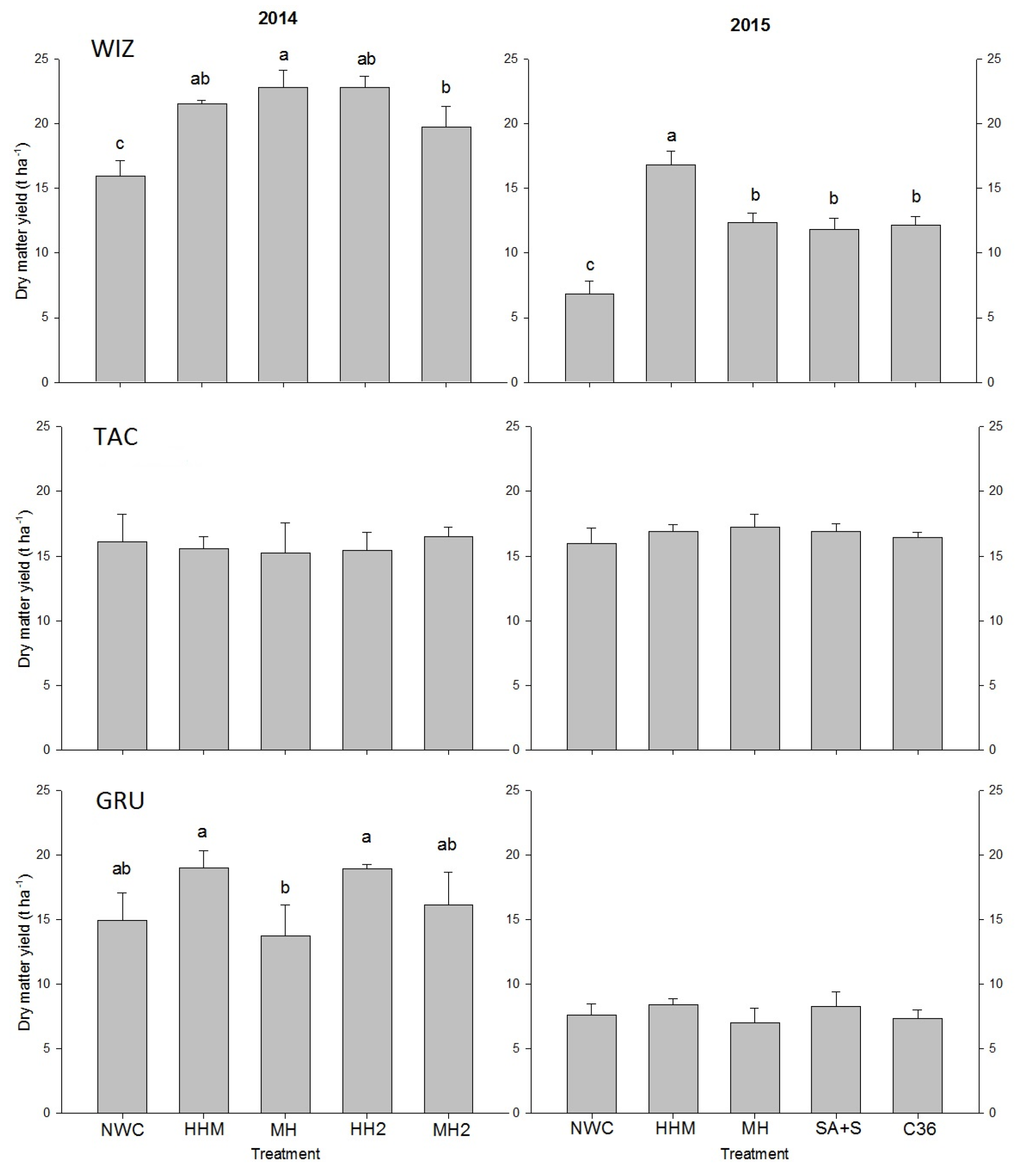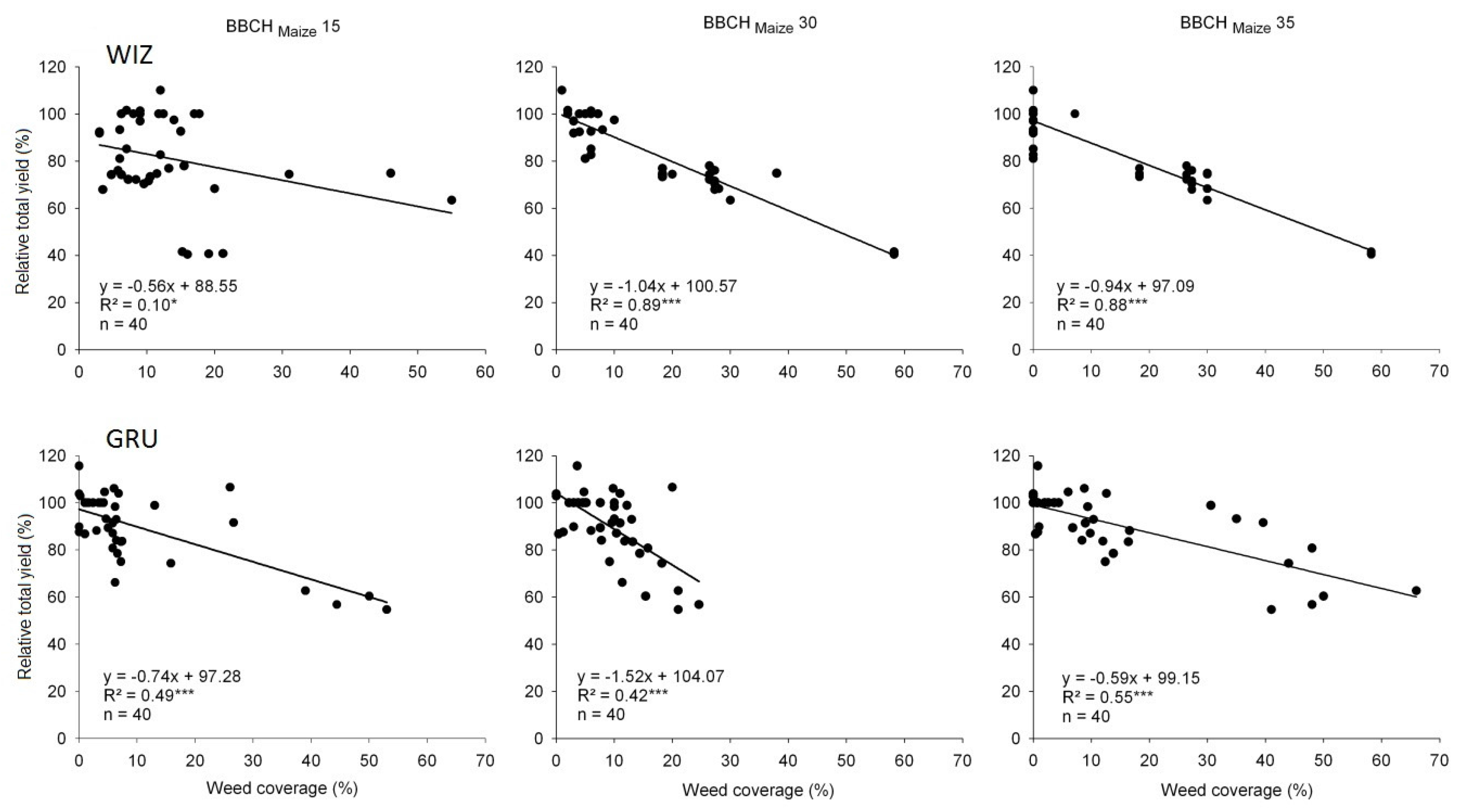Effect of Sowing Method and Weed Control on the Performance of Maize (Zea mays L.) Intercropped with Climbing Beans (Phaseolus vulgaris L.)
Abstract
:1. Introduction
2. Material and Methods
2.1. Experimental Sites and Field Experiments
2.1.1. Experiment I—Intercropping
2.1.2. Experiment II—Weed Control
2.2. Harvest
2.2.1. Experiment I
2.2.2. Experiment II
2.3. Statistical Analysis
3. Results
3.1. Experiment I
3.2. Experiment II
4. Discussion
5. Conclusions
Acknowledgments
Author Contributions
Conflicts of Interest
Abbreviations
| B | bean |
| DM | dry matter |
| e | early |
| GRU | Grub |
| l | late |
| M | maize |
| TAC | Tachenhausen |
| WIZ | Witzenhausen |
References
- Statistisches Bundesamt. Anbaufläche. Available online: https://www-genesis.destatis.de (accessed on 6 July 2016).
- Lithourgidis, A.S.; Dordas, C.A.; Damalas, C.A.; Vlachostergios, D. Annual intercrops: An alternative pathway for sustainable agriculture. Aust. J. Crop Sci. 2011, 5, 396. [Google Scholar]
- Herrmann, A. Biogas Production from Maize: Current State, Challenges and Prospects. 2. Agronomic and Environmental Aspects. Bioenergy Res. 2013, 6, 372–387. [Google Scholar] [CrossRef]
- Thrupp, L.A. Linking Agricultural Biodiversity and Food Security: The Valuable Role of Agrobiodiversity for Sustainable Agriculture. Int. Aff. 2000, 76, 283–297. [Google Scholar] [CrossRef]
- Clawson, D.L. Harvest Security and Intraspecific Diversity in Traditional Tropical Agriculture. Econ. Bot. 1985, 39, 56–67. [Google Scholar] [CrossRef]
- Davis, J.; Roman, A.; Garcia, S. The effects of plant arrangement and density on intercropped beans (Phaseolus vulgaris) and maize II. Comparison of relay intercropping and simultaneous planting. Field Crops Res. 1987, 16, 117–128. [Google Scholar] [CrossRef]
- Francis, C.A.; Prager, M.; Tejada, G. Effects of relative planting dates in bean (Phaseolus vulgaris L.) and maize (Zea mays L.) intercropping patterns. Field Crops Res. 1982, 5, 45–54. [Google Scholar] [CrossRef]
- Searle, P.; Comudom, Y.; Shedden, D.C.; Nance, R.A. Effect of maize + legume intercropping systems and fertilizer nitrogen on crop yielding and residual nitrogen. Field Crops Res. 1981, 4, 133–145. [Google Scholar] [CrossRef]
- Peksen, G. Intercropping Efficiency and Yields of Intercropped Maize (Zea mays L.) and Dwarf Bean (Phaseolus vulgaris L.) Affected by Planting Arrangements, Planting Rates and Relative Time of Sowing. Int. J. Curr. Microbiol. Appl. Sci. 2013, 2, 290–299. [Google Scholar]
- Anil, L.; Park, J.; Phipps, R. The potential of forage-maize intercrops in ruminant nutrition. Anim. Feed Sci. Technol. 2000, 86, 157–164. [Google Scholar] [CrossRef]
- Contreras-Govea, F.E.; Muck, R.E.; Armstrong, K.L.; Albrecht, K.A. Fermentability of corn–lablab bean mixtures from different planting densities. Anim. Feed Sci. Technol. 2009, 149, 298–306. [Google Scholar] [CrossRef]
- Contreras-Govea, F.; Marsalis, M.; Angadi, S.; Smith, G.; Lauriault, L.M.; VanLeeuwen, D. Fermentability and Nutritive Value of Corn and Forage Sorghum Silage When in Mixture with Lablab Bean. Crop Sci. 2011, 51, 1307. [Google Scholar] [CrossRef]
- Dawo, M.I.; Wilkinson, J.M.; Sanders, F.E.T.; Pilbeam, D.J. The yield and quality of fresh and ensiled plant material from intercropped maize (Zea mays) and beans (Phaseolus vulgaris). J. Sci. Food Agric. 2007, 87, 1391–1399. [Google Scholar] [CrossRef]
- Dawo, M.I.; Wilkinson, J.M.; Pilbeam, D.J. Interactions between plants in intercropped maize and common bean. J. Sci. Food Agric. 2009, 89, 41–48. [Google Scholar] [CrossRef]
- Flores-Sanchez, D.; Pastor, A.; Lantinga, E.A.; Rossing, W.A.H.; Kropff, M.J. Exploring Maize-Legume Intercropping Systems in Southwest Mexico. Agroecol. Sustain. Food Syst. 2013, 37, 739–761. [Google Scholar] [CrossRef]
- Gebeyehu, S.; Simane, B.; Kirkby, R. Genotype×cropping system interaction in climbing beans (Phaseolus vulgaris L.) grown as sole crop and in association with maize (Zea mays L.). Eur. J. Agron. 2006, 24, 396–403. [Google Scholar] [CrossRef]
- Javanmard, A.; Nasab, A.D.M.; Javanshir, A.; Moghaddam, M.; Janmohammadi, H. Forage yield and quality in intercropping of maize with different legumes as double-cropped. J. Food, Agric. Environ. 2009, 7, 163–166. [Google Scholar]
- Maasdorp, B.V.; Titterton, M. Nutritional improvement of maize silage for dairying: Mixed-crop silages from sole and intercropped legumes and a long-season variety of maize. 1. Biomass yield and nutritive value. Anim. Feed Sci. Technol. 1997, 69, 241–261. [Google Scholar] [CrossRef]
- Titterton, M.; Maasdorp, B.V. Nutritional improvement of maize silage for dairying: Mixed crop silages from sole and intercropped legumes and a long season variety of maize. 2. Ensilage. Anim. Feed Sci. Technol. 1997, 69, 263–270. [Google Scholar] [CrossRef]
- Stoltz, E.; Nadeau, E. Effects of intercropping on yield, weed incidence, forage quality and soil residual N in organically grown forage maize (Zea mays L.) and faba bean (Vicia faba L.). Field Crops Res. 2014, 169, 21–29. [Google Scholar] [CrossRef]
- Cong, W.-F.; Hoffland, E.; Li, L.; Six, J.; Sun, J.-H.; Bao, X.-G.; Zhang, F.-S.; van der Werf, W. Intercropping enhances soil carbon and nitrogen. Glob. Chang. Biol. 2015, 21, 1715–1726. [Google Scholar] [CrossRef] [PubMed]
- Tsai, S.M.; Da Silva, P.M.; Cabezas, W.L.; Bonetti, R. Variability in nitrogen fixation of common bean (Phaseolus vulgaris L.) intercropped with maize. Plant Soil 1993, 152, 93–101. [Google Scholar] [CrossRef]
- Albino-Garduno, R.; Turrent-Fernandez, A.; Isabel Cortes-Flores, J.; Livera-Munoz, M.; Carmen Mendoza-Castillo, M. Root distribution and solar radiation in maize-bean intercropping systems. Agrociencia 2015, 49, 513–531. [Google Scholar]
- Sadeghi, H.; Kazemeini, S.A.; Edalat, M. Effect of plant density ratios and weed control on the performance of maize-bean intercropping. J. Ecol. Field Biol. 2012, 35, 313–322. [Google Scholar] [CrossRef]
- Coll, M.; Bottrell, D.G. Predator-prey association in mono- and dicultures: Effect of maize and bean vegetation. Agric. Ecosyst. Environ. 1995, 54, 115–125. [Google Scholar] [CrossRef]
- Smith, H.A.; McSorley, R. Intercropping and Pest Management: A Review of Major Concepts. Am. Entomol. 2000, 46, 154–161. [Google Scholar] [CrossRef]
- Zhang, F.; Li, L. Using competitive and facilitative interactions in intercropping systems enhances crop productivity and nutrient-use efficiency. Plant Soil 2003, 248, 305–312. [Google Scholar] [CrossRef]
- Naumann, C.; Bassler, R.; Seibold, R.; Barth, C. Methodenbuch; VDLUFA-Verlag: Darmstadt, Germany, 1976. [Google Scholar]
- Hoppe, C. Development of Biogas Maize Cultivars for Intercropping with Climbing Beans. Ph.D Thesis, Georg-August-Universität Göttingen, Göttingen, Germany, 2016. [Google Scholar]
- IUSS Working Group. World Reference Base for Soil Resources 2014; World Soil Resources Reports No. 106; FAO: Rome, Italy, 2014. [Google Scholar]
- Meier, U. Biologische Bundesanstalt für Land- und Forstwirtschaft. In Growth Stages of Mono- and Dicotyledonous Plants. BBCH-Monograph; Blackwell Wissenschafts-Verlag: Berlin, Germany; Boston, MA, USA, 1997. [Google Scholar]
- R Core Team. R: A Language and Environment for Statistical Computing. Available online: https://www.R-project.org (accessed on 25 May 2016).
- Hauggaard-Nielsen, H.; Jørnsgaard, B.; Kinane, J.; Jensen, E.S. Grain legume-cereal intercropping: The practical application of diversity, competition and facilitation in arable and organic cropping systems. RAF 2008, 23. [Google Scholar] [CrossRef]
- Malézieux, E.; Crozat, Y.; Dupraz, C.; Laurans, M.; Makowski, D.; Ozier-Lafontaine, H.; Rapidel, B.; Tourdonnet, S.; Valantin-Morison, M. Mixing plant species in cropping systems: Concepts, tools and models. A review. Agron. Sustain. Dev. 2009, 29, 43–62. [Google Scholar] [CrossRef]
- Mariotti, M.; Masoni, A.; Ercoli, L.; Arduini, I. Forage potential of winter cereal/legume intercrops in organic farming. Ital. J. Agron. 2006, 1, 403. [Google Scholar] [CrossRef]
- Böttinger, S. Handbuch Mais. Grundlagen, Anbau, Verwertung, Ökonomie; DLG-Verl.: Frankfurt, Germany, 2013. [Google Scholar]
- Graß, R.; Heuser, F.; Stülpnagel, R.; Piepho, H.-P.; Wachendorf, M. Energy crop production in double-cropping systems: Results from an experiment at seven sites. Eur. J. Agron. 2013, 51, 120–129. [Google Scholar] [CrossRef]
- Schittenhelm, S. Effect of Drought Stress on Yield and Quality of Maize/Sunflower and Maize/Sorghum Intercrops for Biogas Production. J. Agron. Crop Sci. 2010. [Google Scholar] [CrossRef]
- Graham, P.H.; Ranalli, P. Common bean (Phaseolus vulgaris L.). Field Crops Res. 1997, 53, 131–146. [Google Scholar] [CrossRef]
- Fischer, J.; Höppner, F.; Böhm, H. Gemengeanbau von Mais mit Phaseolus-Bohnen: Einfluss von Sorte und Saatdichte der Bohnen auf die Bestandszusammensetzung. GPW 2015, 27, 177–178. [Google Scholar]
- Carranca, C. Legumes: Properties and symbiosis. In Symbiosis: Evolution, Biology, and Ecological Effects; Camisão, A.F., Pedroso, C.C., Eds.; Nova Biomedical: Hauppauge, NY, USA, 2013; pp. 67–94. [Google Scholar]
- Hall, M.R.; Swanton, C.J.; Anderson, G.W. The Critical Period of Weed Control in Grain Corn (Zea mays). Weed Sci. 1992, 40, 441–447. [Google Scholar]
- Dierauer, H.-U.; Stöppler-Zimmer, H. Unkrautregulierung ohne Chemie. 28 Tabellen; Ulmer: Stuttgart, Germany, 1994. [Google Scholar]
- Melander, B.; Rasmussen, I.A.; Bàrberi, P. Integrating physical and cultural methods of weed control—Examples from European research. Weed Sci. 2005, 53, 369–381. [Google Scholar] [CrossRef]
- Silgram, M.; Shepherd, M.A. The Effects of Cultivation on Soil Nitrogen Mineralization. Adv. Agron. 1999, 65, 267–311. [Google Scholar]
- Marshall, E.J.P.; Brown, V.K.; Boatman, N.D.; Lutman, P.J.W.; Squire, G.R.; Ward, L.K. The role of weeds in supporting biological diversity within crop fields. Weed Res. 2003, 43, 77–89. [Google Scholar] [CrossRef]
- Aulrich, K.; Meyer, U.; Fischer, J.; Böhm, H. Futterwert von Mais-Bohnen-Silagen: Stangen- und Feuerbohnen im Vergleich. In Ökologischen Landbau Weiterdenken: Verantwortung Übernehmen, Vertrauen Stärken; Wolfrum, S., Heuwinkel, H., Reents, H.J., Hülsbergen, K.J., Eds.; Verlag Dr. Köster: Berlin, Germany, 2017; pp. 96–100. [Google Scholar]
- Nurk, L.; Graß, R.; Pekrun, C.; Wachendorf, M. Methane Yield and Feed Quality Parameters of Mixed Silages from Maize (Zea mays L.) and Common Bean (Phaseolus vulgaris L.). Bioenergy Res. 2016. [Google Scholar] [CrossRef]



| Name | Witzenhausen (WIZ) | Tachenhausen (TAC) | Grub (GRU) | |||
|---|---|---|---|---|---|---|
| Geographical location | 51°23′ N, 9°54′ E | 48°39′ N, 9°23′ E | 48°09′ N, 11°47′ E | |||
| Height above sea level (m) | 228 | 361 | 526 | |||
| Soil type * | Luvisol | Luvisol | Cambisol | |||
| Farming system | organic | conventional | conventional | |||
| Year | 2014 | 2015 | 2014 | 2015 | 2014 | 2015 |
| Preceding winter crop | Wheat | Rye | Wheat | Wheat | Barley | Barley |
| Fertilizer (kg ha−1) | none | none | 100 Nm | 106 Nm | 100 Nm, 30 P, 35 S | No 51, Nm 70 |
| Soil parameters: | ||||||
| pH | 6.4 | 6.6 | 6.6 | 6.4 | 6.3 | 7 |
| P (mg 100 g−1) | 9 | 10 | 17 | 4 | 24 | 24 |
| K (mg 100 g−1) | 9 | 11 | 33 | 19 | 16 | 34 |
| Annual total rainfall (mm) | 563 | 506.4 | 816.5 | 456.5 | 814.8 | 561.5 |
| Average rainfall 1985–2015 (mm) | 629 | 718.1 | 884.7 | |||
| Annual mean temperature (°C) | 10.7 | 10.8 | 11 | 11.7 | 9.9 | 10.9 |
| Average temperature 1985–2015 (°C) | 8.2 | 10.4 | 8.9 | |||
| WIZ | TAC | GRU | ||||
|---|---|---|---|---|---|---|
| 2014 | 2015 | 2014 | 2015 | 2014 | 2015 | |
| Maize | ||||||
| Sowing date | 29 April | 06 May | 15 April | 10 April | 06 May | 08 May |
| Harvest date | 06 October | 30 September | 01 October | 28 August | 29 September | 01 September |
| (days after sowing) | (160) | (147) | (169) | (140) | (146) | (116) |
| BBCH | 83 | 83 | 83 | 80 | 83 | 80 |
| Beans | ||||||
| Sowing date early | 02 June | 29 May | 22 May | 11 May | 06 June | 01 June |
| Sowing date late | 13 June | 26 June | 04 June | 29 May | 13 June | 13 June |
| Harvest date | 06 October | 30 September | 01 October | 28 August | 29 September | 01 September |
| (days after early sowing) | (126) | (124) | (132) | (109) | (115) | (92) |
| Harvest date | 06 October | 30September | 01 October | 28 August | 29 September | 01 September |
| (days after late sowing) | (115) | (96) | (119) | (91) | (108) | (80) |
| BBCH of early (late) sown beans | 76 (62) | 76 (62) | 76 (62) | 59 | 76 (62) | 59 |
| Abbreviation | Maize Seeds m−2 | Bean Seeds m−2 | Bean Sowing Time |
|---|---|---|---|
| 10M | 10 | ||
| 7.5M + 7.5B (e) | 7.5 | 7.5 | early |
| 7.5M + 5B (e) | 7.5 | 5 | early |
| 5M + 7.5B (e) | 5 | 7.5 | early |
| 5M + 5B (e) | 5 | 5 | early |
| 7.5M + 7.5B (l) | 7.5 | 7.5 | late |
| 7.5M + 5B (l) | 7.5 | 5 | late |
| 5M + 7.5B (l) | 5 | 7.5 | late |
| 5M + 5B (l) | 5 | 5 | late |
| Year | 2014 | 2015 | ||||
|---|---|---|---|---|---|---|
| Maize BBCH | 15 | 30 | 35 | 15 | 30 | 35 |
| WIZ | ||||||
| Date | 17 June | 9 July | 28 July | 16 June | 9 July | 16 July |
| Treatment | ||||||
| NWC | 38.0 a | 29.0 a | 30 | 17.9 a | 58.2 a | 58.2 a |
| HHM | 6.9 b | 3.8 b | 0 | 7.3 b | 7.2 b | 7.2 b |
| MH | 9.0 b | 4.5 b | 0 | 8.9 b | 18.3 b | 18.3 b |
| HH2 | 10.5 b | 4.3 b | 0 | 12.1 a,b | 27.3 a,b | 27.3 a,b |
| MH2 | 9.8 b | 6.8 b | 0 | 10.4 a,b | 26.4 a,b | 26.4 a,b |
| TAC | ||||||
| Date | 6 June | 1July | 15 July | 25 June | 6 July | 30 July |
| Treatment | ||||||
| NWC | 1.7 a | 10.5 a | 16.7 a | 9.5 a | 17.2 a | 19.1 a |
| HHM | 0.0 b | 0.0 b | 1.8 b | 0.0 b | 2.8 c | 0.0 c |
| MH | 1.0 a,b | 5.2 a,b | 12.4 a,b | 7.9 a | 14.4 a,b | 13.6 a,b |
| SA + S | 0.3 b | 0.9 b | 2.3 b | 2.1 b | 3.5 b,c | 3.5 b,c |
| C36 | 0.0 b | 2.5 b | 5.3 a,b | 7.7 a | 12.9 a,b,c | 14.1 a,b |
| GRU | ||||||
| Date | 12 June | 2 July | 17 July | 23 June | 15 July | 4 August |
| Treatment | ||||||
| NWC | 18.4 | 16.8 a | 47.2 a | 6.1 a,b | 10.5 a | 10.4 a |
| HHM | 1.2 | 5.7 a,b | 2.7 b | 3.5 b,c | 4.7 b | 1.0 a |
| MH | 33.9 | 14.1 a | 35.1 a | 6.7 a | 11.2 a | 11.0 a |
| SA + S | 0.1 | 1.5 b | 0.3 b | 1.4 c | 2.5 b | 2.0 b |
| C36 | 19.5 | 15.2 a | 36.8 a | 6.6 a | 11.0 a | 10.8 a |
© 2017 by the authors. Licensee MDPI, Basel, Switzerland. This article is an open access article distributed under the terms and conditions of the Creative Commons Attribution (CC BY) license (http://creativecommons.org/licenses/by/4.0/).
Share and Cite
Nurk, L.; Graß, R.; Pekrun, C.; Wachendorf, M. Effect of Sowing Method and Weed Control on the Performance of Maize (Zea mays L.) Intercropped with Climbing Beans (Phaseolus vulgaris L.). Agriculture 2017, 7, 51. https://doi.org/10.3390/agriculture7070051
Nurk L, Graß R, Pekrun C, Wachendorf M. Effect of Sowing Method and Weed Control on the Performance of Maize (Zea mays L.) Intercropped with Climbing Beans (Phaseolus vulgaris L.). Agriculture. 2017; 7(7):51. https://doi.org/10.3390/agriculture7070051
Chicago/Turabian StyleNurk, Liina, Rüdiger Graß, Carola Pekrun, and Michael Wachendorf. 2017. "Effect of Sowing Method and Weed Control on the Performance of Maize (Zea mays L.) Intercropped with Climbing Beans (Phaseolus vulgaris L.)" Agriculture 7, no. 7: 51. https://doi.org/10.3390/agriculture7070051





